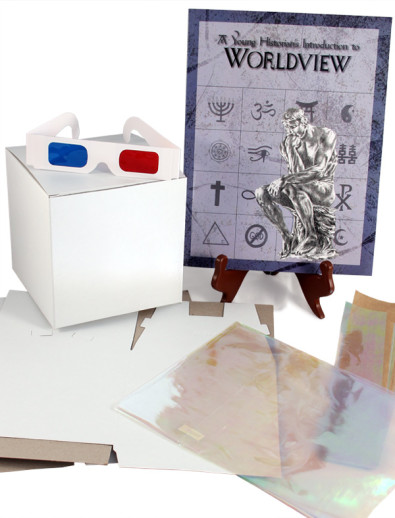We use cookies to make your experience better. To comply with the new e-Privacy directive, we need to ask for your consent to set the cookies. Learn more.
Young Historians Introduction to Worldview
It happens to me once in awhile. I start skimming through a curriculum product and then realize I've slowed down and am reading it thoroughly. This is one of those products. I might be inclined to call it a "practically perfect" introduction to worldview. Designed as a four-lesson unit study and targeting a middle school audience, it provides instructional information, illustrative hands-on activities, and well-developed questions and talking points for family discussions. The lessons move from defining worldview, to finding the commonalities between worldviews, to identifying four worldview "families" (polytheism, monotheism, pantheism, and naturalism) and placing the world's religions in these families, and finally to evaluating the impact of worldview on history. The student is led into discovery: learning to think and evaluate for himself. And, perhaps most important for this age group, they are given tools by which they can continue the evaluation process.
The Guide is written directly to the student with the parent serving more or less as an administrator. This is an effective presentation methodology because many parents are unfamiliar with these topics and uncertain how to present them. Here, they can become co-learners. Both the instructional segments and the hands-on activities (designed to illustrate and lead the student into understanding) are well-laid out, thoroughly explained and easy to follow. The harder-to-find supplies are provided with the remainder being household/office items. Lessons include definitions, instruction, hands-on activities, processing explanations, review and Table Talk (guidelines for family discussion). Literature selections are used with some lessons to provide discussion points and to further clarify the instruction. The Appendix includes reproducible (for the family) copies of worksheets, literature selections, and a summary of 12 different worldviews. The "very back" of the guide includes nine cardstock pages which are used for some of the lesson activities. The curriculum packet includes the Guide plus pre-cut wrapping papers, three white boxes (flattened, six-inch cubes), and a pair of 3-D glasses. 87 pgs. pb. ~ Janice
| Product Format: | Softcover Book |
|---|---|
| Brand: | BrimWood Press |
| Grades: | 5-8 |
| ISBN: | 9780977070497 |
| Length in Inches: | 12.25 |
| Width in Inches: | 10.75 |
| Height in Inches: | 0.5 |
| Weight in Pounds: | 1.35 |

